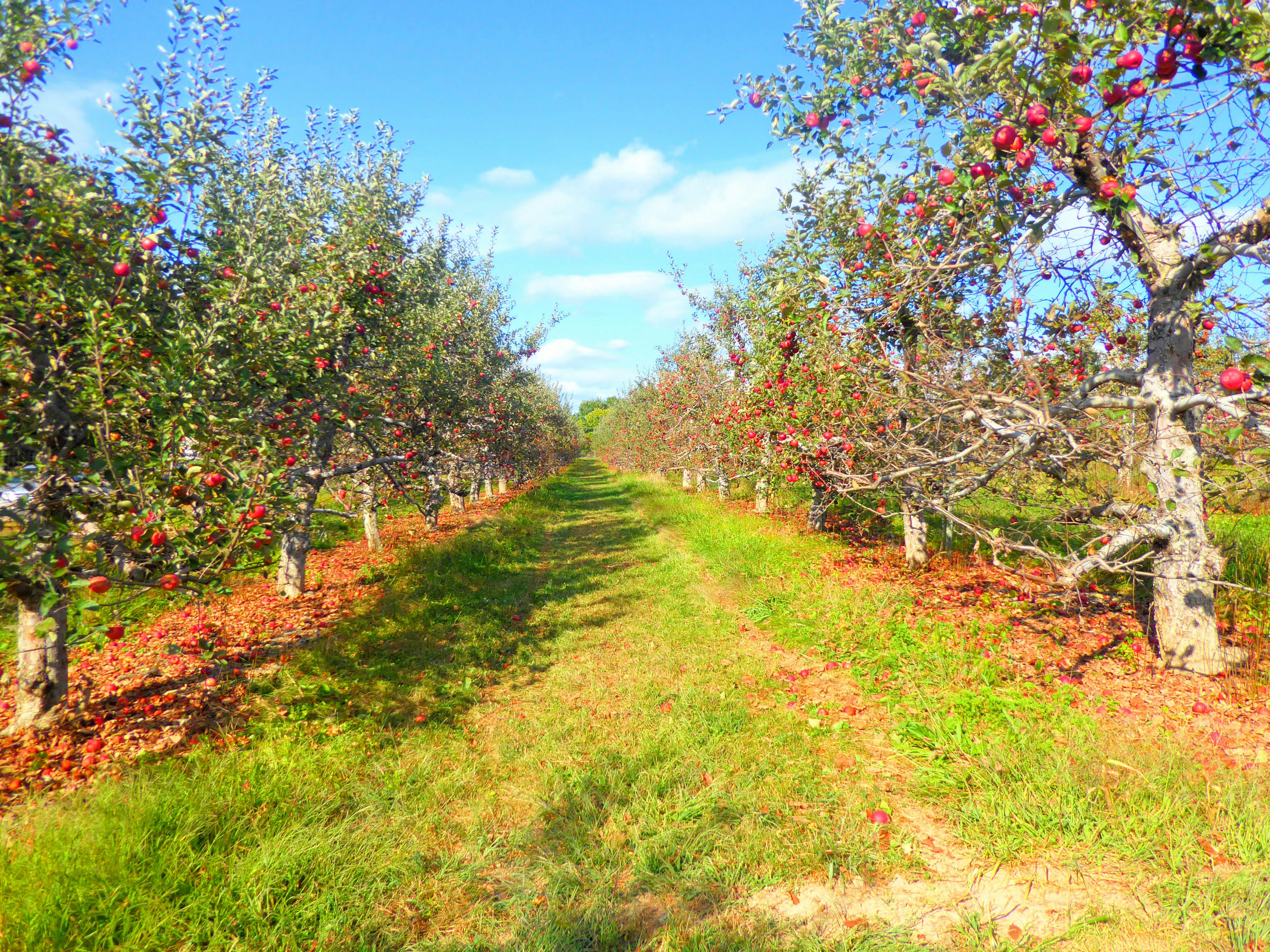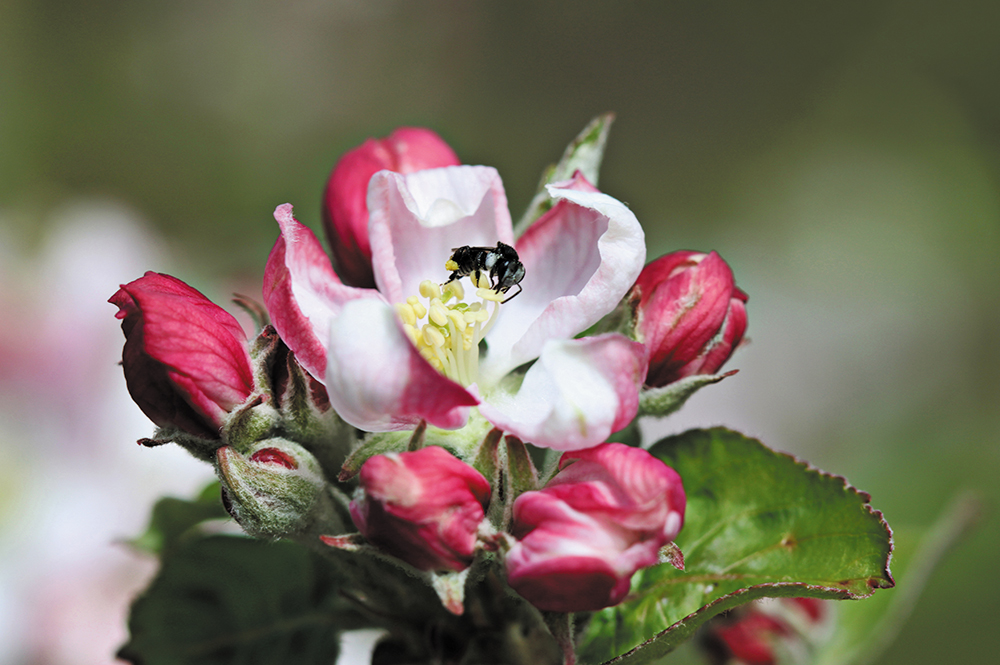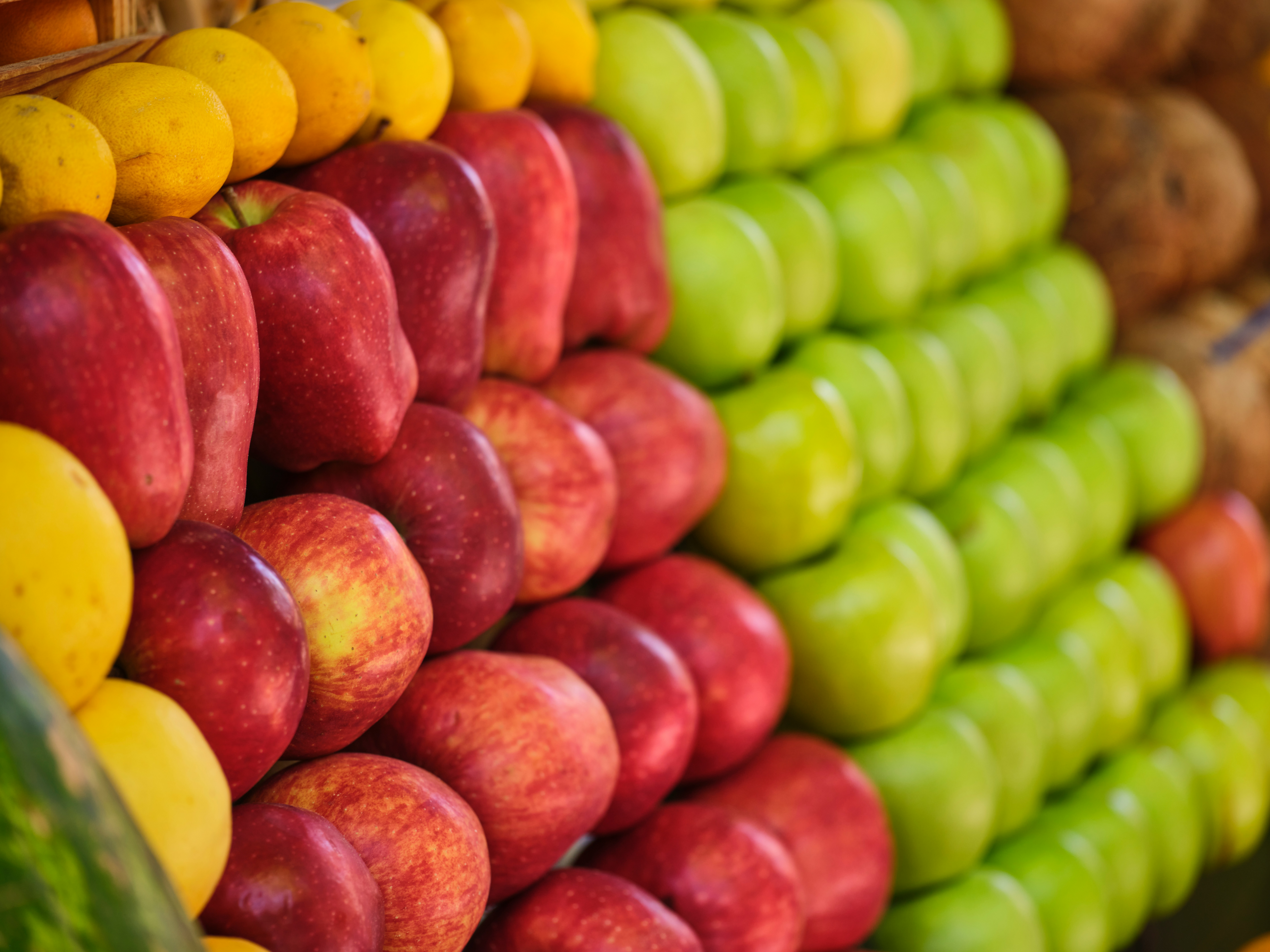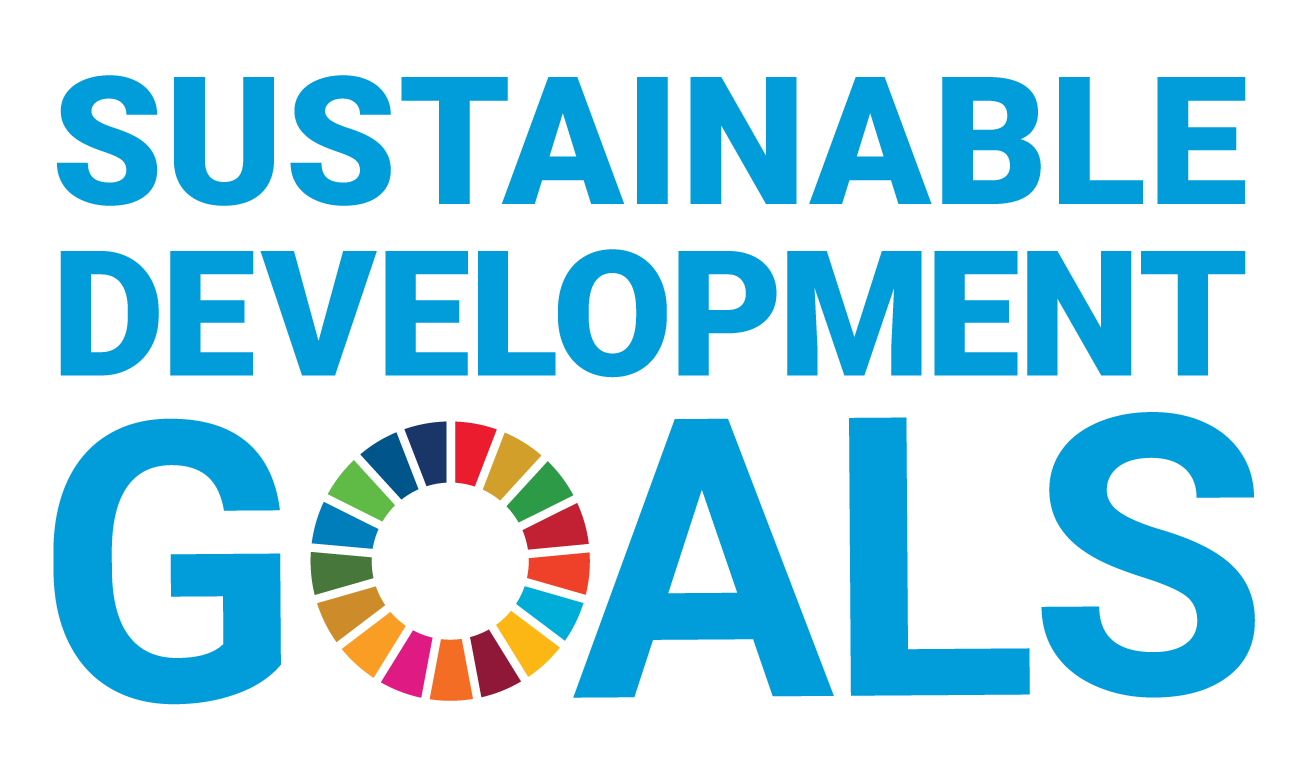You can search for courses, events, people, and anything else.
At Bill Shields’ apple orchard in the Blue Mountains of New South Wales, there’s almost as much focus on flowers as there is on fruit.
An abundance of plants in flower flourish between rows of trellis-trained apple trees and in surrounding garden beds. Depending on the season, these blooms range from the broad, bright yellow faces of sunflowers to delicate, blue, star-like inflorescences of borage plants.
This floral display is not just for show. It’s there to act as an enticing buffet for local pollinator communities, including the native stingless bee (Tetragonula carbonaria). “On our farm, there are lots of flowers, and even flowering weeds, so there’s always something around for pollinators,” Shields says.
Dozens of insect species visit his flowers, and around half carry pollen. He knows this because Shields Orchard, located just outside the town of Bilpin, New South Wales, was involved in a Western Sydney University-led project investigating the role of native pollinators in sustainable food production.
Around 75% of Australian crops benefit from pollination. Some — including most apple cultivars — can’t produce fruit without it. Most pollination is enabled by commercial hives and feral nests of the introduced European honeybee (Apis mellifera).
But overall, insect pollinators have declined worldwide in recent years, due to pesticide use, pathogen exposure, habitat destruction and climate change. Now, another major threat looms in Australia, a mite known as Varroa destructor.
The rapidly spreading parasite can wipe out honeybee colonies. Despite biosecurity controls, Varroa was detected near Newcastle in 2022, and in September 2023, the National Management Group, which coordinates the national Varroa mite response, declared that the species had established itself beyond the possibility of eradication.
Entomologist Professor James Cook, from Western’s Hawkesbury Institute for the Environment, says farmers can no longer take honeybee pollination for granted.
And there’s plenty at stake: the Australian apple industry alone is worth more than half a billion dollars each year. In light of this, farmers and scientists are investigating whether native wild insects — which are not directly attacked by Varroa — might pick up some of the pollination slack.
EATING A BALANCED DIET
While the lion’s share of Australia’s crop pollination work currently falls to honeybees, native insects ferry pollen around crops too.
To discover how much they contribute to orchard pollination, a fieldwork team led by ecologist Dr Amy-Marie Gilpin, also from Western, conducted insect surveys at other NSW apple orchards in Bilpin and Orange.
During the 2017 and 2018 springtime flowering seasons, the team identified and counted insect visitors to blossoms from the Granny Smith and Pink Lady varieties of apples in nine orchards.
They found honeybees dominated orchards in Orange, accounting for at least 85% of apple flower visitors. At Bilpin, honeybees were also common visitors, but the native species Tetragonula carbonaria frequently dropped by apple flowers too.
During warmer weather, stingless bees easily outnumbered honeybees. Stingless bees don’t like the cold, and won’t leave their home until the air temperature hits around 18°C. But when it was warm enough, they emerged en masse, and the researchers sometimes counted 20 stingless bees to every honey bee, Shields adds.
Orchards with a diverse range of flowering plants growing around fruit trees were visited by pollinators more often than those with fewer flowers.
Like humans, insects have food preferences, and might prefer to visit a tasty lavender spike and leave the apple blossoms alone. But also like us, insects benefit from a balanced diet. So while they might only visit apple flowers part of the time, Gilpin says a diverse choice of flowers in an orchard keeps them coming back, increasing overall crop pollination.
The Western team conducted a similar study at sweet cherry (Prunus avium) orchards in Bilpin, Orange and further afield in Young, New South Wales, and found the same trend.
“All of our research indicated that there are only benefits for crop pollination from having co-flowering plants within orchards,” Gilpin says.
Need to know
- Varroa mite has established itself in Australia.
- It poses a serious threat to agriculture that is reliant on honey bees as pollinators.
- Native insects, such as stingless bees, may offer a solution.
“we’re getting benefits from having bushland closer to crops.”
ATTRACT POLLINATORS
Data from Gilpin and Cook’s project, which was primarily supported by Horticulture Innovation Australia, a not-for-profit, grower-owned research and development company, will help inform farmers of new approaches to maximise pollination.
For instance, growers in the past would clear vast swathes of native bushland around fruit trees, thinking pollinators would be forced to stay inside the orchard and maximise pollination.
“But actually, we’re getting benefits from having bushland closer to crops, not just for floral resources, but also native pollinator habitat,” Gilpin says.
Maintaining habitat close by is important because native bees don’t generally roam as widely as honeybees. Even stingless bees, which live in large colonies, tend to stay within a few hundred metres of their home, Cook says.
“So if you’re looking for free pollination benefits from wild bees, you don’t want them to have to travel very far.”
To help growers attract and maintain their pollinator army, Dr Lena Schmidt, who is now at the University of New England, has collaborated with Greening Australia to develop a native wildflower seed mix tailored to Bilpin’s pollinating inhabitants.
The idea is to give pollinators access to nectar and pollen year-round, so when one plant species stops flowering, another has already begun.
Cook, Gilpin and colleagues are also studying the types of pollinators visiting other crops such as mangoes, macadamias and avocados, and examining ways to support the expansion of managed stingless bee hives across the country.
In Bilpin, Shields continually adds to his orchard’s floral ensemble to shore up his local pollinator population. When Varroa mite inevitably reaches his orchard, he and his apple trees will be as ready as possible.
“If we’ve got any spare land, we will quite often plant some bee seed mix in it, to encourage bees to stay around. We’re very sympathetic to the bee population,” Shields says.
“I’ve always been keen to have researchers on the property, because I can pick their brains and learn quite a lot. And that’s had a big impact on the way we’ve managed the place.
Meet the Academic | Dr Amy-Marie Gilpin
Dr Amy-Marie Gilpin is a lecturer in the School of Science at Western Sydney University. Her research centres on understanding the effect of fire on plant-pollinator networks. Amy-Marie is interested in the ecology and conservation of invertebrate and vertebrate pollinators and the pollination function they provide within both natural and agricultural ecosystems. Her research to date has largely focussed on identifying interactions between pollinators and the plants they rely upon. She has also worked extensively on agriculturally important crops within both temperate and tropical regions of Australia. In addition, Amy-Marie’s research focusses on ways to conserve pollinators within agricultural and urban areas with particular focus on floral resources and nesting habitat to support healthy pollinator populations within these systems. Amy-Marie employs a variety of methods from multiple disciplines including large-scale manipulative field and glasshouse experiments to determine the effects of climate change on floral resources and pollinators. She uses an integrative approach to understand firstly who the pollinators are and then what is their effect on surrounding plants, ecosystems, plant mating systems, seed fitness as well as fruit quality and yield.
Meet the Academic | Professor James Cook
Professor James Cook is leader of the Plants, Animals and Interactions research theme at the Hawkesbury Institute for the Environment. His research interests lie in the ecology and evolution of species interactions, and he is particularly interested in how intimate symbiosis influences the biology of the species involved. Pollinators are a special interest, and his current research focuses mainly on insect pollinator communities and their role in pollination of horticultural crops. He is also an expert on specialist pollination systems, such as the classic mutualism between fig trees and wasps, while another research priority centres on insects and their endosymbiotic bacteria.
James is currently leading three projects to better understand the role of insects in pollination of Australian horticultural crops and developing resilient pollination options in the face of threats to honeybee populations. These projects cover research on crop pollination, stingless bee biology and husbandry, seasonal floral resource use by bees, bee health and diseases, and managed pollination with flies. His research involves field, laboratory and glasshouse approaches and makes extensive use of molecular methods. His research involves links with collaborators in Australia, India, China, France, UK, and USA. James also has wider research interests in animal behaviour, conservation biology and evolutionary genetics. James has a BA (Zoology) from Oxford University and PhD (Evolutionary Biology) from Imperial College London. His previous academic posts have been at La Trobe University, Imperial College London, and the University of Reading.
Credit
Future-Makers is published for Western Sydney University by Nature Research Custom Media, part of Springer Nature.
© karinkim/Unsplash
© enginakyurt/Unsplash






